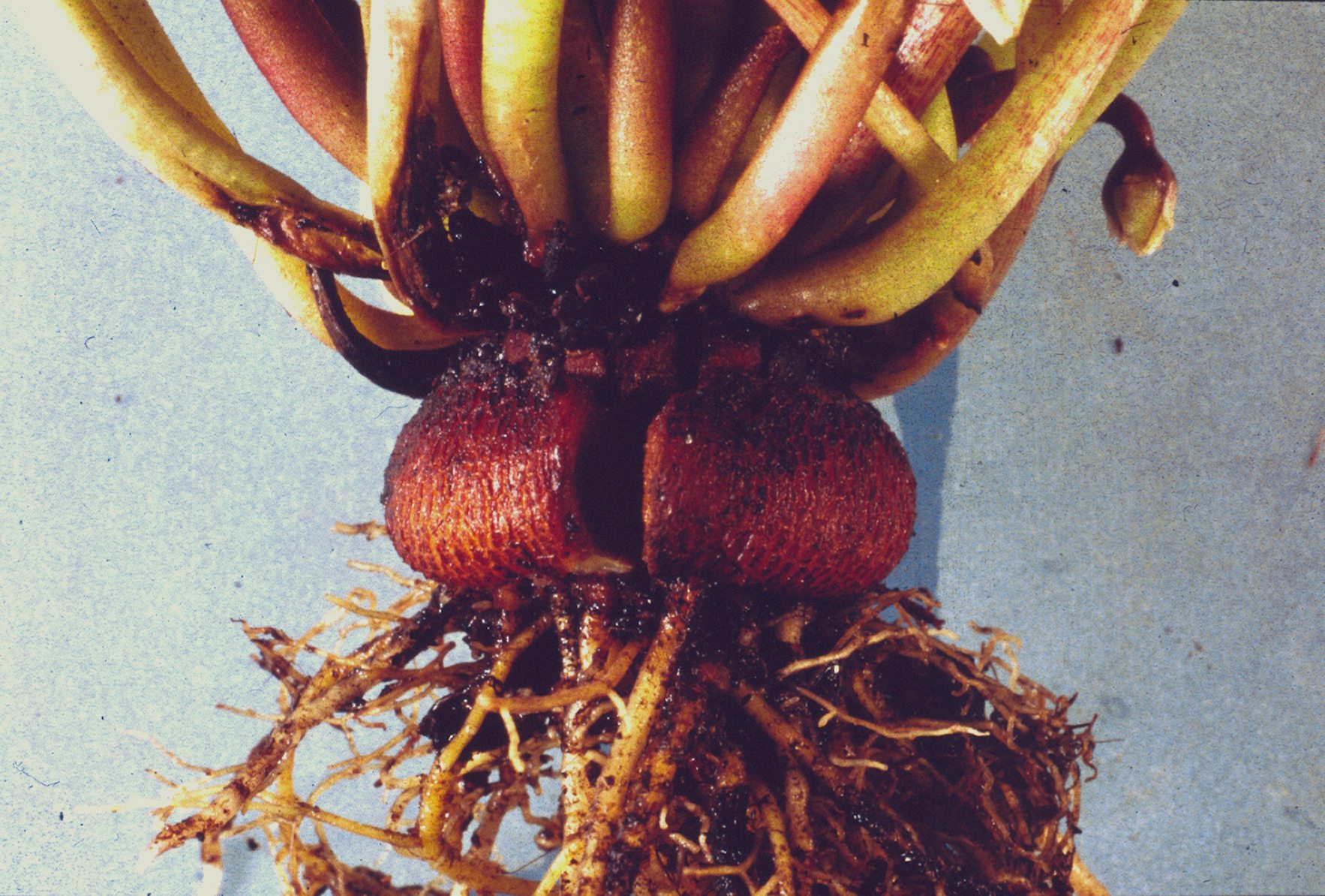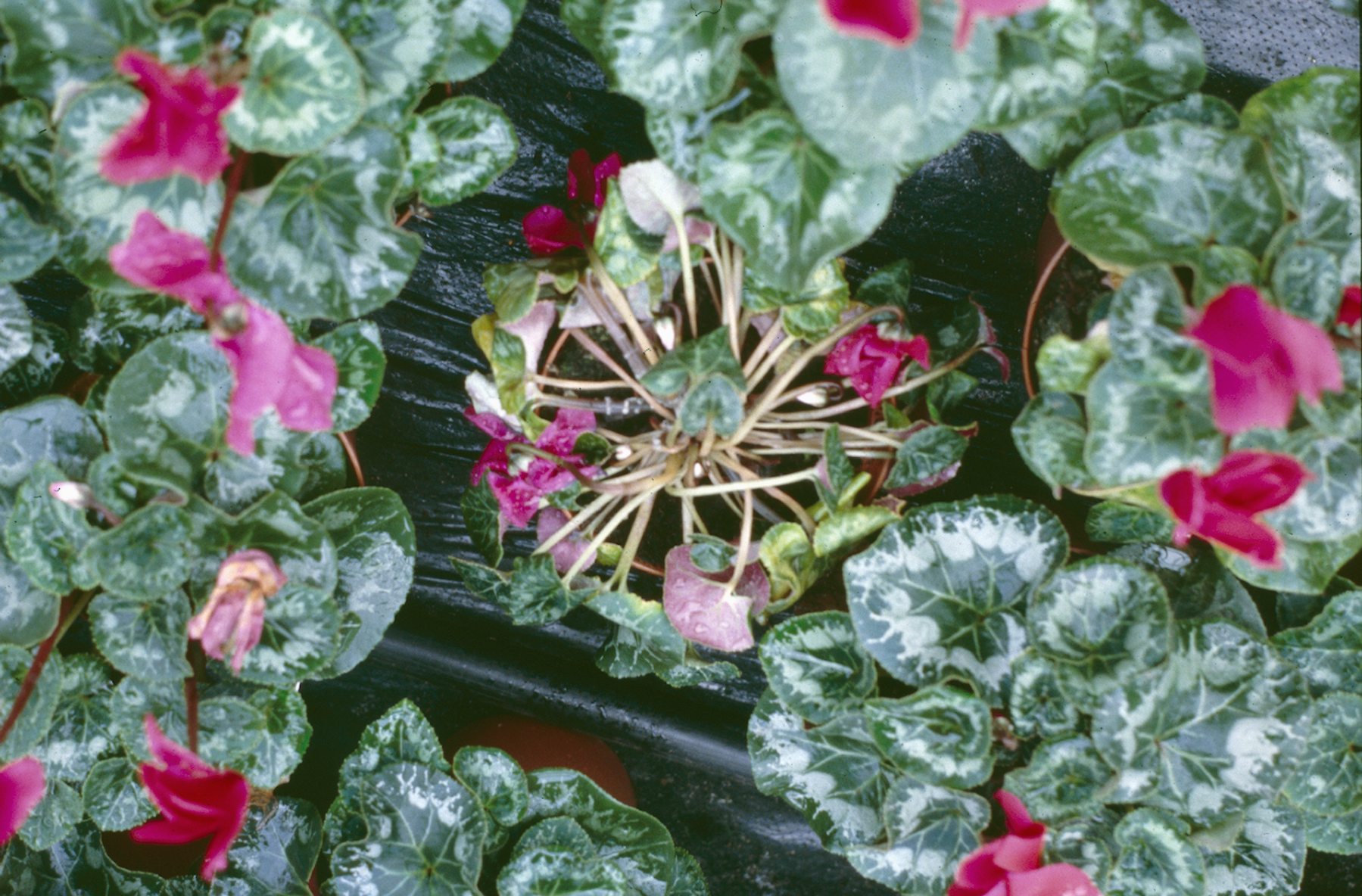Please click here to access the main AHDB website and other sectors.
- Home
- Knowledge library
- Cyclamen disease management
Cyclamen disease management
Read about how disease management can only be optimised by adopting a range of cultural and chemical control methods.
Back to: Disease control in cyclamen
Cultural control
Cultural control measures will reduce the development of disease and the need for fungicide inputs and are an essential part of any disease management programme.
Pre-cropping
- Clean and disinfect standing areas, including capillary matting (where reused). If fusarium wilt or phytophthora root rot occurred in the previous cyclamen crop, or if any of the root diseases occur at a high level, replace the matting
- Cover water storage tanks to prevent contamination by pathogens such as Pythium species and Phytophthora species and test the water source for pathogens
- Cover open bales, bags or bulk growing media to prevent contamination by dust or crop debris containing resting spores of root pathogens
During cropping
- Consider using a growing medium containing up to 40% composted pine bark or woodfibre, with nutrition adjusted accordingly
- Ensure young plant specifications complement your method of planting; long petioles are often damaged by planting machines
- Plant carefully to reduce wounding and ensure that the top of the corm is well above the growing medium surface to reduce the risk of bacterial soft rot
- Irrigate regularly but not to excess. Irregular watering can lead to cracks developing in the corm through which bacterial soft rot can enter. Wet growing media will favour the development of black root rot, Pythium and Phytophthora
- Reduce the spread of Botrytis, Colletotrichum and Fusarium spores by water splash, as well as stopping periods of persistent leaf wetness, by using a sub-irrigation system
- Where water is recirculated, water treatment by chemical or biological filtration is likely to be necessary to remove pathogens
- Avoid high nitrogen feeds which lead to soft growth and increased disease susceptibility
- Avoid damaging foliage and flowers, increasing the susceptibility to Botrytis
- Avoid pot thick spacing and increase airflow to reduce periods of high humidity and prolonged leaf wetness. Good air movement will help to harden plant growth and reduce petiole length
- Use glasshouse shading and/or shade screens to help minimise plant stress
- Avoid holding autumn pack bedding cyclamen past their optimum stage: Botrytis can become a serious problem due to the dense foliage and fallen flowers
Environmental control
- Use ventilation fans and shading to reduce very high temperatures. At 20–25ºC or higher, the risk of anthracnose, bacterial soft rot and fusarium wilt increases, as well as a risk of delayed crop establishment
- Closely monitor and reduce humidity levels by a combination of plant spacing, ventilation, fans and, later in the growing season, heat boosts. These cultural techniques will help to minimise the incidence of Botrytis
- Avoid sudden drops in air temperature at flowering as these can lead to condensation so increasing Botrytis risk
Nursery hygiene
- Ensure that senescent leaves and flowers are removed promptly, especially at the later stages of crop development
- Monitor and control pests such as thrips and aphids, as well as sciarid and shore fly which may spread spores of Colletotrichum species, Fusarium species, Pythium species and Thielaviopsis species
- Promptly remove diseased plants to limit secondary disease spread. Carefully bag plants before removal to avoid spreading spores of Botrytis or Fusarium
- Ensure that diseased material and other crop debris is removed off-site or kept in covered skips or heaps, well away from production areas, prior to disposal
Bioprotectant and fungicide use
Preventative programmes should utilise both bioprotectants and fungicides and must be carefully managed to achieve the most effective control, while minimising the risks of phytotoxic damage, spray deposits and resistance development (see Table 1 for further information).
Growth cracks in the corm predispose plants to bacterial soft

Courtesy and copyright ADAS Horticulture.
Remove diseased and dying plants promptly

Courtesy and copyright ADAS Horticulture.
Table 1. Fungicides with activity against a range of diseases affecting cyclamen. Products are currently permitted on protected ornamentals either by on-label approval or by Extension of Authorisation for Minor Use (EAMU), together with their mode of action classification by their Fungicide Resistance Action Committee (FRAC) group
|
Example product |
Active ingredient |
FRAC group |
Approval status |
Disease activity |
|
Amistar |
Azoxystrobin |
11 |
3388/18 |
Botrytis, fusarium wilt, anthracnose, bacterial soft rot |
|
Amylo X WG |
Bacillus amyloliquefaciens subsp. plantarum strain D747 |
Not applicable |
0428/19 |
Botrytis, anthracnose, fusarium wilt, Pythium, Rhizoctonia, bacterial canker, bacterial soft rot |
|
Frupica SC |
Mepanipyrim |
9 |
1294/19 |
Botrytis |
|
Luna Privilege |
Fluopyram |
7 |
0289/21 |
Powdery mildew |
|
Plant Trust |
Fosetyl-aluminium |
33 |
On-label |
Root rots |
|
Prestop |
Gliocladium catenulatum strain J1446 |
Not applicable |
On-label |
Botrytis, fusarium wilt, Phytophthora, Pythium, Rhizoctonia |
|
Proplant |
Propamocarb hydrochloride |
28 |
0785/16 |
Root rots |
|
Reflect |
Isopyrazam |
7 |
2975/18 |
Botrytis |
|
Romeo |
Cerevisane |
Not applicable |
1449/21 |
Botrytis, downy mildew, powdery mildew |
|
Scala |
Pyrimethanil |
9 |
1315/11 |
Botrytis |
|
Sercadis |
Fluxapyroxad |
7 |
4348/19 |
Botrytis |
|
Serenade ASO |
Bacillus subtilis strain QST 713 |
Not applicable |
2364/18 |
Botrytis, powdery mildew, bacterial soft rot |
|
Signum |
Boscalid + pyraclostrobin |
7 + 11 |
2141/12 |
Botrytis, anthracnose, bacterial soft rot |
|
Subdue |
Metalaxyl-M |
4 |
On-label |
Root rots |
|
Switch |
Cyprodinil + fludioxonil |
9 + 12 |
On-label |
Botrytis, fusarium wilt, anthracnose |
- The information in this table has been collated using information from the Health and Safety Executive (HSE) website (www.pesticides.gov.uk) and from suppliers’ labels and product technical information. Important – regular changes occur in the approval status of plant protection products, arising from changes in the legislation or for other reasons. For the most up to date information, please check the HSE website or with a professional supplier or BASIS-qualified consultant, as information could have changed since this table was produced
- EAMU – Extension of Authorisation for Minor Use
- Growers must hold a paper or electronic copy of an EAMU before using any product under the EAMU arrangements. Any use of a plant protection product with an EAMU is at the grower’s own risk
- Always follow approved label or EAMU recommendations, including the rate of use, the maximum number of applications per crop or year and where crop safety information is not available, test the product on a small number of plants to determine crop safety prior to widespread commercial use
Bioprotectants
Bioprotectant products are available for use against a range of diseases in protected ornamental production, including cyclamen:
- Amylo X WG (Bacillus amyloliquefaciens D747) has activity against Botrytis, Colletrotrichum, Fusarium, Pythium, Rhizoctonia and bacterial diseases
- Prestop (Gliocladium catenulatum) has activity against Botrytis and can be applied as a foliar spray to control this disease. It also has activity against Fusarium, Phytophthora, Pythium and Rhizoctonia and can be applied as a drench
- Serenade ASO (Bacillus subtilis strain QST 713) has activity against Botrytis, powdery mildew and bacterial infections
Chemical fungicides
The text below highlights some of the most commonly used fungicides authorised to treat fungal diseases of cyclamen. The fungicides listed are not exhaustive and others are available, on-label or applied under an Extension of Authorisation for Minor Use (EAMU). Products applied to cyclamen under any EAMU are done so at the grower’s own risk and should be trialled on a small scale before widespread application. Growers should refer to relevant EAMUs before using products authorised for use on ornamentals under an EAMU.
Botrytis: Despite the loss of many key actives in recent years including chlorothalonil, several fungicides with activity against Botrytis remain including; Amistar (azoxystrobin), Frupica (mepanipyrim), Reflect (isopyrazam), Sercadis (fluxapyroxad), Signum (boscalid and pyraclostrobin) and Switch (cyprodinil and fludioxonil). Some batches of cyclamen seed have been found to carry Botrytis, while some plants may suffer latent systemic infection. As a precaution treat plants from an early stage of growth, preferably using a fungicide with some systemic activity, such as Signum. The intensity of any Botrytis fungicide programme will be determined by the prevailing weather, the production structures used (risk is greater in poorly heated and ventilated glasshouses with overhead irrigation) and the spacing density adopted (densely packed crops are more prone).
Anthracnose: Due to the infrequent occurrence of anthracnose in cyclamen crops there has been no recent studies investigating chemical control. Amistar, Signum and Switch are reported to have good activity against Colletotrichum species.
Bacterial soft rot: Good nursery hygiene is key to limit the impact of bacterial infections. Infected plants should be disposed of swiftly as bacterial infections can spread in water splash. Including bioprotectants, such as Serenade ASO and Amylo X WG, in spray programmes can help to prevent bacterial infections. Fungicides such as Amistar and Signum can also help to ‘strengthen’ plants reducing susceptibility to infection.
Fusarium wilt: Fusarium infection occurs largely through the roots. Fungicides need to be targeted at the roots by high volume application. Products with some activity against fusarium wilt include Amistar and Switch.
Root rots: Growing media incorporation of fungicides pre-planting like Plant Trust (fosetyl-aluminium), or drenches after planting such as Proplant (propamocarb hydrochloride) and Subdue (metalaxyl-M), represent the most effective chemical control strategy for root rot diseases. Treatments are generally repeated once or twice at four to six week intervals where the risk of root disease is considered to be high. It is important that the cause of root rot is correctly identified in order to select an effective chemical treatment.
Virus diseases: No products are available to treat any plant virus, including TWSV, INSV or CMV. All efforts must be made to avoid introductions onto sites, prevent spread where infections occur and eliminate infections before the introduction of subsequent crops. Where diseases are spread by insect vectors, like, thrips or aphids, these should be well controlled.
Devising programmes
Fungicide use will vary depending upon the production system adopted and disease history on the nursery. Key points to consider when using fungicide include:
- Monitor crops carefully to identify disease outbreaks as soon as possible
- Ensure the cause of disease problems are correctly identified and the correct product is selected
- Preventative treatments are generally more effective
- Commence Botrytis preventative treatments early when it’s easier to get good crop coverage
- Always use two or more products from different fungicide groups for sequential treatments against any particular pathogen (especially Botrytis) to avoid disease resistance
- Be aware of the potential of some products to cause crop damage or leave a visible deposit, and any restrictions in terms of number of applications, re-entry intervals or need for personal protective equipment on the label approval or EAMU
- Use the application method and dose rate stated on the label approval or EAMU
Useful links
Further information can be found in the following AHDB factsheets:
15/05: Use of chemical disinfectants in protected ornamental production
21/15: Testing water for plant pathogens
22/15: Methods of water treatment for the elimination of plant pathogens
23/15: Hygiene and disease avoidance underpin the management of oomycete stem and root rots
Authors
Author(s) – Dave Kaye and Erika Wedgwood. ADAS Horticulture.
Original author(s) – Tim O’Neill and John Scrace. ADAS Horticulture.
Webpage content correct as of May 2021.
Topics:
Sectors:
Tags:

